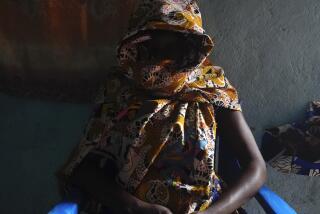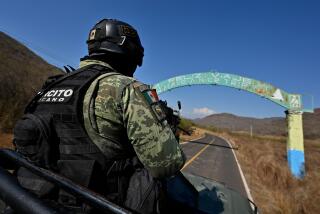Blowtorch Cuts Rebel Arms in Salvadoran Ceremony : Central America: Weapons’ destruction at isolated encampment is key to U.N.-brokered peace accords.
- Share via
EL PAISNAL, El Salvador — His hands trembling, a young Salvadoran guerrilla guided the blue flame of a blowtorch through the middle of an M-60 machine gun on Wednesday, initiating the destruction of the rebel arsenal used to battle U.S.-backed forces during 12 years of civil war.
In an emotional and historic ceremony at an isolated rebel encampment, 50 rifles, pistols and grenade launchers were destroyed under the scrutiny of United Nations peacekeepers, as more than 100 demobilized rebel fighters and their families crowded around to watch.
“Criminal!” someone shouted out as the first weapon was rendered useless. Soon his cry was overtaken by solemn shouts of “Long live the FMLN!”--initials in Spanish for the leftist Farabundo Marti National Liberation Front.
For many in the crowd, the ceremony marked the final punctuation of a long, bloody struggle that left thousands dead. And, for some, it was hard to take.
“I do not want to dramatize this moment, but it is a historic moment for El Salvador,” said Iqbal Riza, head of the U.N. mission here. “El Salvador is moving from war to peace.”
Destruction of the guerrilla weapons is a central element in U.N.-brokered peace accords signed last January. It was seen as the most difficult step the rebels had to take.
It came only after President Alfredo Cristiani, in a confidential letter, pledged to U.N. Secretary General Boutros Boutros-Ghali that he would carry out a far-reaching purge of the Salvadoran armed forces.
Rebel commander Leonel Gonzalez, who headed Wednesday’s ceremony at El Paisnal, said the dismantling of the rebel arsenal was important to portray to the world the guerrillas’ willingness to comply with the peace accords.
But he quickly cautioned that if “minority sectors” of the government or military try to derail the peace process, the guerrillas will react.
“Have no doubts,” he said, “the FMLN will suspend the destruction of their weapons. Those are the rules of the game.”
Leading up to Wednesday’s gun destruction, the guerrillas on Tuesday submitted to U.N. observers an inventory of their arsenal. Rebel spokesmen have indicated the list contains about 5,200 pieces of equipment, plus “dozens” of the rebels’ prized antiaircraft missiles. Previous inventories failed to include a substantial portion of materiel, and it remained to be seen whether this most recent version would be accepted by the United Nations and the Salvadoran government.
The rebels also have said the missiles will be among the last weapons to be destroyed because the weapons have served as the rebels’ “negotiating card.” They credit the use of surface-to-air missiles with neutralizing the government’s air war against the insurgent forces.
Throughout the last decade, rebel armies in El Salvador used weapons largely acquired from the Sandinistas of Nicaragua and from Cuba to fight an army financed mightily by Washington. The two sides battled until it seemed neither could win; they were forced to the negotiating table last year.
Most, though not all, of the guns destroyed at El Paisnal, a bastion of rebel support 25 miles north of San Salvador, were in good condition, U.N. officials said. Similar ceremonies, with teams of guerrillas using torches and trained by the United Nations, were scheduled to take place in 14 other rebel encampments Wednesday.
At El Paisnal, the guerrilla with the acetylene cutting torch, identified by his nom de guerre , Rojas, worked slowly in a clearing at the foot of a rocky embankment. Children climbed trees to get a better view, and former fighters and U.N. monitors jostled to take pictures.
An assistant placed the U.S.-made M-60 on top of a brick oven-like structure for the operation. As Rojas cut in a spot just beyond the trigger guard, the flame hit impurities in the gun’s metal, sending bright orange sparks two feet into the air and bringing a gasp from the crowd.
Once he disposed of the M-60, Rojas tackled two Soviet-made grenade launchers, then an AK-47 automatic rifle. The assistant held aloft the pieces of each disabled weapon for the crowd to see, the metal still glowing brightly and smoke filling the air.
The guerrillas have several plans for the gun pieces. They want to put some in a yet-to-be-built guerrilla museum and use some to build a monument to the war, while some, Gonzalez said, will be sold as souvenirs.
Before the weapons were sliced, a contingent of about 40 rebels was demobilized at the El Paisnal camp. As the thick smell of tortillas wafted by, they listened to speeches and the national anthem, received “diplomas” thanking them for their contribution to the war and turned in their guns to return to civilian life.
“Our power is not in the guns but in the people . . . in the ideas and the conviction that this country must be transformed,” Gonzalez, the rebel commander, told the gathering. “We will remain a force in the political struggle.”
A lone official from the U.S. Embassy had also traveled to El Paisnal. He looked on from the audience.
More to Read
Sign up for Essential California
The most important California stories and recommendations in your inbox every morning.
You may occasionally receive promotional content from the Los Angeles Times.











